Kia ora! A short week, but there’s a plethora of cool things to share once again.
The week in Greater Auckland
Tuesday’s post, a guest post by Anna Michels, explained the health benefits of greenery in urban places.
On Wednesday, Jolisa explored the awesome and the not so awesome things about Tāmaki Makaurau’s two new shared paths.
Yesterday, Matt wrote about the upcoming upgrade to the Albert St interchange – and its 5-month closure.
Phil Goff’s final budget steers Auckland towards climate action
The passing of Auckland’s annual budget this week was an important milsestone: it locked in the $57m Climate Action Targeted Rate, which has a big focus on investing in active modes and public transport. As reported by Todd Niall, Goff sent councillors a strong message about climate change and being a good ancestor.
Goff challenged councillors considering voting against CATR to ask themselves whether action was needed, and whether there was public support for action – the answer to both of which, he said, was a “Yes”.
Goff said if he was asked by his grandchildren in 10 years’ time, what he had done against global warming, he wanted to have the right answer.
“I was part of a council that did what was required when the evidence was put in front of it, that action was required,” he said.
National policy to make it easier for council to change streets
This is a bit of a ‘wait and see’ scenario, but it’s looking promising. Newsroom reports that the Ministry for Transport has been working on changes to the legislation that governs how roads can be used, to make it easier for councils to do things like remove parking.
The planned changes are part of enacting the Emissions Reduction Plan and encouraging people to get out of cars and use other modes. Existing legislation relied on is more than 50 years old and can complicate things for councils trying to get moving with road reallocation.
Councils increasingly rely on provisions in the Local Government Act 1974 and the Transport Regulations 1965 to make street changes, with officials telling Wood this approach was less costly and time consuming than creating in-house bylaws – but it was not fit-for-purpose.
“The provisions were written in the 1960s and 1970s, and were created to support closing the road when road maintenance, constructions, short term public events, or natural disasters occur. They were not created to support permanent road space reallocation.”
Proof of EV subsidy success
You’ve probably noticed exponentially more electric vehicles cruising around over the last few months. Well, it looks like the subsidy is working better than expected: new registrations of EVs has grown quickly, while fossil fuel vehicle registrations are dropping.
And yes, those changes come from a very low and very high base respectively – but these shifts mean that in just 2 months, average emissions for new registrations are nearly where Government had hoped they’d be by 2023.
To us, that sounds like an argument for a much more ambitious target.
Since Clean Car feebate came in on 1 April, the nationwide EV & hybrid vehicle fleet has grown by 14,500, while the petrol & diesel-only fleet has *shrunk* 8,000
Average emissions for new registrations down 14% in 2 months, nearly at 2023 target alreadyhttps://t.co/Amn046vAyN
— Clint Smith (@ClintVSmith) June 6, 2022
Covering the Dom Post covering urbanism
The Dominion Post has put out so much excellent content about transport and urban issues this week that we’re not going to be able to cover it all! We’ll bring you our highlights, and encourage heading over to explore the section further.
Chris Bruntlett’s advice for Pōneke
Kate Green interviewed Chris Bruntlett, of the Dutch Cycling Embassy (and Modacity fame) about the challenges and benefits of mode shift. The interview is packed full of excellent, clearly explained talking points – including some that frame the discussion brilliantly:
Mode shift is the tool, not the end game. More people cycling creates a more liveable, social city, with fewer metal boxes pushing pollution into the air, making noise and creating stress. We’re making eye contact at intersections and negotiating our fellow human beings to move around the city.
He also spoke about the importance of political leadership when we’re changing the way we get around.
It’s really important to remember people aren’t idealistic or altruistic in their mobility choices. They will ultimately only choose other modes if it makes getting from A to B quicker. So this can’t come from the ground up – there has to be leadership at the political level to put the network in place.
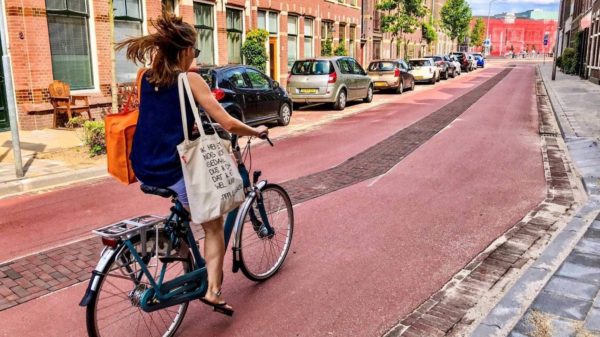
Newtown residents are fans of the Newtown cycleway
It’s so valuable to hear from the voices of the people actually using the infrastructure: the parents, kids, and workers of Newtown who’ve been riding along the Newtown Cycleway since it opened. These are people who want to get around in a lower-carbon way – and in some cases, are bravely already doing so – and the new, humble, interim version of the cycleway makes them feel safe and welcomed.
“When it’s rush hour, it’s the one part of the commute where I feel really safe and I know that my kids are safe,” said Sharlene Maslin, who cycles with her husband Stephen and their two sons, five-year-old Finn and three-year-old Leon, to Newtown school and Capital Kids daycare.
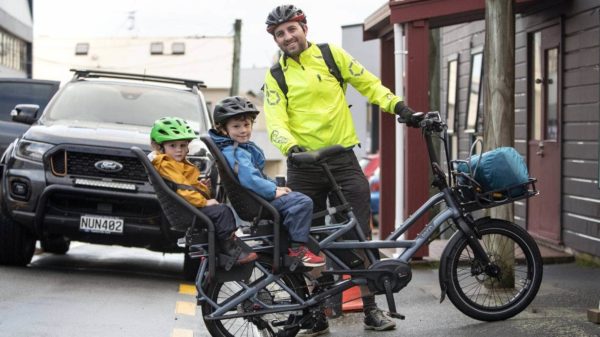
But will the Newtown cycleway be forced off-course?
The group that took Wellington City Council to court over the cycleway has just won an interim injunction, and construction has been paused. The case led to a storm of counter-criticism from advocates, who pointed out that the same bits of road are often illegally blocked by car transporters delivering vehicles to the car sales businesses in the opposing group.
Green MP Julie Anne Genter vented her frustration in a tweet, criticising the dealerships for delaying the cycleway while they “block whole traffic lanes daily” with car trucks.
Patrick Morgan from Cycle Wellington criticised the “bizarre” informal agreement between the council and car yards which allowed transporters to offload vehicles with no traffic management.
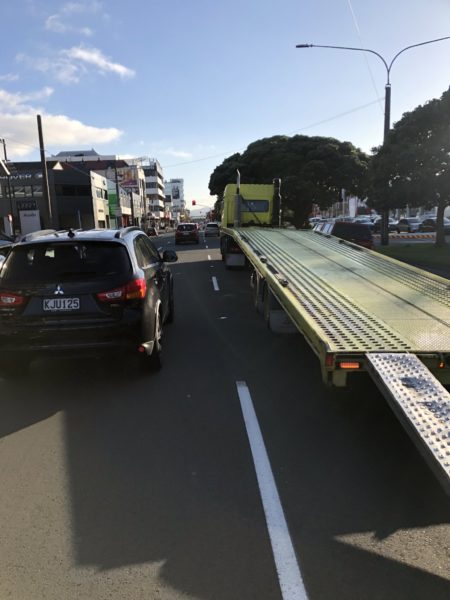
And Julie Anne Genter followed up with an opinion piece, reminding the cyceway’s opponents that by stopping it from being built, they’re putting kids’ lives at risk.
Now we have to wait. My baby may be a year old before our commute is safe. A small group of local car yard owners and other businesses has gone to court to force work on the protected cycleway and bus lanes to stop, led by Myles Gazley of Gazley Motors. Six months feels like an unbearably long time. It will be half her life so far. Every day, twice a day, I will wonder if something will go catastrophically wrong on our journey.
But the Newtown Bike Bus prevails!
Can this be called anything other than momentum? Footage taken on World Bicycle Day, for extra impact.
Decided to get morning coffee in #Newtown cos it's already less traumatic to get there on bike from Thorndon at rush hour, thx to #cycleway … and see this #cargobike #schoolrun This you @CycleWgtn ? pic.twitter.com/vSmkL25PRr
— Isabella Cawthorn (@fixiebelle) June 2, 2022
The week in flooding washes through Wellington
Staying in the capital for one more section, it’s very stormy right now in Wellington. Localised tornadoes, heavy winds, and cascades of water down inner-city streets have all been recorded today, and the city is being warned to brace for more dramatic weather tomorrow.
Woodward Street today at lunch time – my office is across the river. pic.twitter.com/v112F0Rk0Q
— Hayley (@korahawhare) June 9, 2022
Taupō’s waterfront goes car-free
It used to be State Highway 1, and now Taupō waterfront is going to become a pedestrian friendly space with much reduced traffic. Local businesses are excited about the opportunity it will bring.
Taupō Town Centre general manager Julie McLeod said cafes and restaurants would benefit once the work was complete.
“In the 10 years that I’ve been in this role, it is definitely the most exciting project that will bring the greatest amount of change and cool opportunities for our businesses,” she said.
“The changes are going to bring big areas of outdoor dining looking out to our beautiful lakefront and the new cultural space that is going to be created, so we are really excited about this world-class precinct.”
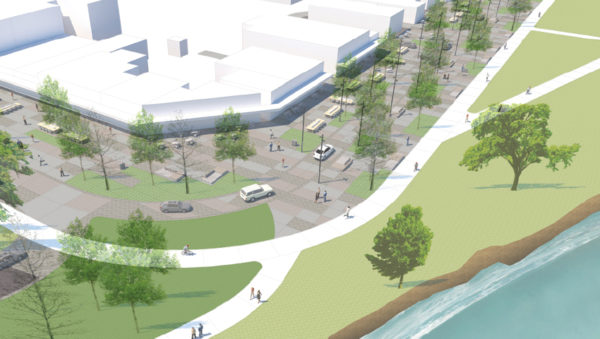
Not a train we’d ride
We had a less-than-enthusiastic reaction to news of this scenic train trip to view progress on … the Peka Peka to Ōtaki expressway.
This is so typical of this terrible city: have fun with the train network, which we do our best to make sure is only fit for aesthetics and heritage, while we get on with ignoring climate change by building *big important* roads to induce exurban sprawl. https://t.co/AbDie9rgxH
— Pàra (@cogtwitoergosum) June 7, 2022
Meanwhile, the future of train services for everyday travel on those same tracks remains unclear, with the government failing to provide funding for a fleet of hybrid electric trains in the budget. Will it find funding as part of the Horizon’s Regional Public Transport Plan? Several submitters thought so…
There were also several calls for a better connection between Taranaki and Whanganui, particularly to and from Hāwera.
In its summary of submissions Horizons said there was broad support for more rail trips to be made available throughout the region – specifically for passenger travel.
“A number of suggestions were received regarding use of the rail network to provide passenger rail to communities such as Taihape, Taumarunui, Whanganui and Dannevirke and interregionally to Napier and Taranaki,” the summary said.
Trains we would absolutely ride
If we could, that is! Seen on twitter, Nicola Welten came across a wonderful set of luggage-label drawers that recall a time when trains were how most people moved around Aotearoa.
People are most definitely riding Te Huia
And the fare’s still just $9 from Frankton to The Strand! (With a Bee Card.)
https://twitter.com/davemacpherson7/status/1533968577224900608?s=12&t=FG9JsCFIuIxU1jFwljegYA
Bikes are the solution for car-choked megacities
Did you know that in the 90s, China was a bicycle kingdom and 670 million people owned bikes? But now, mega-highways dominate China’s mega-cities.
That’s where this Financial Times article starts, about the effects of cars on the world’s 30+ megacities, and how it’s not too late for those same cities to be reclaimed by bicycles. The argument is particularly strong for poorer megacities, which might not have the funds for sophisticated public transport systems.

Cities aren’t loud – cars are loud
A simple fact too easily forgotten about. It’s experiences like these – temporary street closures, trial bike lanes – that demonstrate to communities how welcoming and humane their cities can be when space isn’t prioritised for cars.
Sunday evening on the Fifth Avenue open street. What always strikes me is the quiet. A regular reminder that cities aren’t loud, cars are loud. pic.twitter.com/YXxDahnVuw
— Doug Gordon (@BrooklynSpoke) June 6, 2022
Free ebikes for food delivery workers
The food delivery business is growing, but with rising fuel prices, drivers of fossil fuel cars are taking a financial hit. Instead of giving out rebates, San Francisco’s Department of the Environment is piloting giving delivery drivers ebikes to use instead of cars or motorbikes. The scheme is starting with 35 delivery drivers.
The drivers – riders! – will be provided with a full cycling kit including locks, panniers, rain jackets and other accessories. Their vehicle data will be collected and compared to a control group still using cars.
Already, some delivery drivers are being converted. The global e-bike company Zoomo opened a San Francisco outpost in 2019, renting e-bikes to delivery workers for $25 to $61 per week, before insurance and extras. Zoomo also sells used e-bikes starting at about $1,000 and new ones starting at $2,700 — close to industry standards.
Transit with a story
A lovely idea that *hey, CRL…* we can imagine working very well here: ticket dispensers in train stations that spit out not tickets, but stories in a receipt-like form. Something to read on the train that’s not our phones! Originating in France (of course?) the Bay Area Rapid Transit has them too, and is running a competition for local writers to provide short stories on the theme of ‘transit’.
Wouldn’t that be a fantastic way to tell tales of Tāmaki Makaurau/Auckland, and the stories behind new CRL station names?
Cargo by sail
File this under yes please, for now and into the future, and can I stow away? A 110 year old wooden schooner has been refurbished and is providing zero-emissions cargo delivery in the northern hemisphere. Run by SailCargo, the Vega has other advantages over fossil-fuel cargo ships too: it’s nimbler, smaller, and easier to unload.
Because it doesn’t use shipping containers—goods are loaded on pallets—it also has some logistical advantages. “Some of these fast vessels have to wait at port often up to two weeks, because they’re dependent on the port infrastructure,” says Doggett. “They need the big crane to unload the container. We do not—we can unload ourselves.”
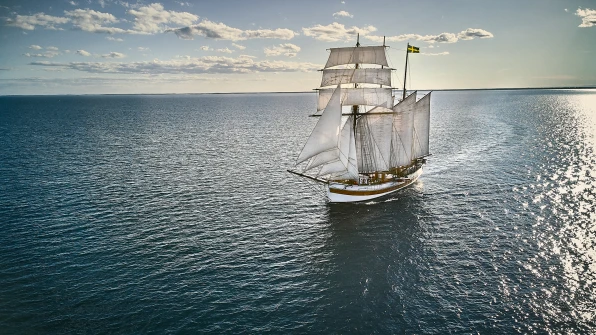
Reading list
We’re excited to get our hands on a copy of Movement, just out this month, which is subtitled how to take back our streets and transform our lives.
Join journalist Thalia Verkade and urban mobility expert Marco te Brömmelstroet as they confront their own underlying beliefs and challenge us to rethink our way of life to put people at the centre of urban design. But be warned: you will never look at the street outside your front door in the same way again.
It’s true, we just want boring things
https://twitter.com/_dmoser/status/1533103330339311617?t=fW6uQPwhi0OpEAUTxaOY1A&s=19
Ka kite! Hope your weekend is full of boring stuff like uneventful bike rides, chill walks, and reliable PT.
Header image: Nicola Welten, via Twitter.






 Processing...
Processing...
Wow, I had missed that the government hadn’t funded the regional train sets, how ridiculous
Maybe they are thinking to complete the electrification of the Main trunk and throw in Hamilton to Mount Maunganui and Upper Hutt to Masterton as well. I don’t think anyone is suggesting that electrification could be justified to run passenger trains obviously the biggest carbon saving would be for freight. But my thoughts is that having battery/diesel/overhead hybrid train sets would be useful even with electrification. Also electrification would be a long term process maybe 10 years if there was support from all parliamentary parties and Kiwirail. Even then things can change with new management at Kiwirail or even new technology. Another factor to take into account is the performance of the DL locomotives. It’s not exactly stellar maybe Kiwirail sees electrification and the purchase of new electric locomotives along with the upgrade of the EF’s as a means to gaining more reliable locomotive power. Obviously they had to take what they were given when they were purchased and but even so I don’t expect they can go back to the Govt and ask for more diesel replacements for ten year old machines. And think about why Stadler locomotives were chosen in preference to North American for the replacement of the South Island locomotive fleet. Possibly because it is a very reputable electric and battery locomotive manufacturer although the official reason is that Stadler offered double cab while competitors didn’t. One other reason for Stadler is an European free trade deal just like the milk for locomotive deal with the Chinese. Anyway enough speculation maybe I am reading too much into the tea leaves.
https://www.stuff.co.nz/dominion-post/wellington-top-stories/128894240/first-refurbished-electric-locomotive-rolls-off-the-line-as-35m-overhaul-gets-up-to-speed
NZ Herald counted between 4 and 8 cyclists over 4 morning peaks using the Richmond Rd Surrey Cres cycleway that cost $9.9million. On page A4 this morning.
The one that was started never finished, with much of it closed and used for carparking? It is so tortuous and flawed, with the original design focusing entirely on increasing and preserving car parks that it’s surprising even 4 people are using the small bits that exists. The piece on Old Mill Road is equally pointless, it’s entirely blocked by vehicles parked on driveways which AT doesn’t enforce making it a further example of bad infrastructure generated when the primary aim is preserving on street carparks.
I stood on Emily Place this morning for 5 mins and counted two vehicles…
Least reliable major paper in New Zealand publishes least believable statistic in a major New Zealand paper.
Yawn
Evidence to the contrary?
On the last 4 mornings at peak,l counted 2 people on the footpath outside our house,l demand that there be no further maintenance on such little used infrastructure, and the space reallocated to vehicle parking,which is used 24/7
Did they spend $9.9 million on it? That is terrible.
Does that lane still smack into the parked cars around Edwards Road and spit you out into traffic just after Warnock Street?
Not sure if Streetview is up to date. I’d take my kids along that path, but what to do at either end where it gives up?
I take it back, I wouldn’t take my kids on it. How did they manage to drop nearly 10 million on a path that literally invites drivers to echelon park over it outside any shop?
How much aggressive traffic calming could that have paid for?
Are they trying to argue for higher housing density?
Clearly Orsman’s actually lobbying for better local safety and a connected network. :/ And highlighting the amount of money that got wasted on retail consultants because the business community were toxic, and the amount of money that got swallowed up in endless scope changes and redesign… He’s asking AT to grow some facial hair and save our rates by doing things once by doing things well.
NZTA put on a train, for people to go look at a road being built. They the sent the coms people to try sell the benefits of this specifically terrible roading on social medial, in shadow of trains not being funded?
New Zealand has become a real life comedy sketch.
NZTA putting on trains to show off the benefits of bulding more roads.
Council sueing each other to stop a 4 level development going ahead.
Council vetoing Greenfields sites yet vetoing inner city densification.
The list is endless..
gold
Sometimes I feel bad for those comms people. Eg they’re trying to sell Otaki to North of Levin. “First and foremost this is a safety project” is the leading line. Yet it sucks funding out of projects that would have vastly higher safety per dollar, and therefore would have brought way more safety overall.
In some ways is a negative safety project. The NZTA are presented with a set of projects / finding projects, and they have chosen the one that will provide the least safety for the given amount of money. And then to have to get up and spout that this is a safety project in the press, and how they’re a vision zero organisation.
How do they sleep at night?
I get very confused with NZTA. They start to get the fact that we could just have marginally slower roads, save billions, have less emissions and end up with a safer transport system. Then they revert to “moar roadz “, completely undermining their previous messaging.
Jak at least KR know how to slow down and stop traffic as seen on the Te Huia last Tuesday Afternoon when heading North through Huntly ;-
Might have been a coal train coming across the bridge, they go very slowly.
Next time I do the trip I’ll check it out again .
NZTA did not put on this train. Steam Inc did, and would have made quite a bit of money from all those passengers.
One tweet apparently makes for “a less-than-enthusiastic reaction”.
Sigh.
In other news I hope and pray that it preforms well.
https://www-dev.newshub.co.nz/home/new-zealand/2019/08/ports-of-auckland-to-get-world-s-first-fully-electric-tug.html
Sorry this is the link I wanted to post.
https://electrek.co/2022/06/08/meet-sparky-the-electric-tugboat-operating-in-the-ports-of-auckland-with-2784-kwh-of-power/
In terms of slightly less… historical cosplay… style sail cargo ships, the French food company Grain De Sail is constructing a €10M modern sailing cargo ship to take 350T of trans-Atlantic cargo, to supplement its existing 50T sail cargo vessel. It’s still pretty small, but it’s a start:
https://www.offshore-energy.biz/grain-de-sail-orders-its-next-wind-powered-freighter/
Cosplay is a fairly accurate description. Their current ship can carry the equivalent of about 2 containers. Their new ship 12 or so.
The speed of unloading quote also sounds a little cherry picked. Half the reason for the introduction of containers was that traditional cargo ships took forever to load and unload. Similar with bulk cargo like grain.
Interesting that SailCargo are touting not having containers as a benefit.
Given how containers totally revolutionised world cargo, it’s interesting that small, bespoke cargo solutions are coming back into use. Makes sense to me, we could use more coastal shipping in NZ for sure.
The Strand is not downtown Auckland.
For someone my age (73) it is quite a long walk, as I found last week
If you could short cut through the old station grounds it would be a lot shorter. But of course, all flogged off in the 90s with zero vision or concern for future rail users.
Yeah I thought about this the other day. Why can’t we at least use the old railway building as a walking/public thoroughfare to the Te Huia platform….
Because it got sold off for apartments
S L ;- Ana a future Clown of the USA wanted to buy it and to turn it into a casino until Internal Affairs looked into his background and told him NO .
Christopher Randal ;- I’ve found the easiest way is get the Train to Puhinui to catch the Te Huia and coming back from Hamilton get off there and get the Subbie to Britomart ,.
“You’ve probably noticed exponentially more electric vehicles cruising around over the last few months. Well, it looks like the subsidy is working better than expected: new registrations of EVs has grown quickly, while fossil fuel vehicle registrations are dropping.
And yes, those changes come from a very low and very high base respectively – but these shifts mean that in just 2 months, average emissions for new registrations are nearly where Government had hoped they’d be by 2023.
To us, that sounds like an argument for a much more ambitious target.”
I suspect that those figures for the two months might not show much at all. It appears that most people who wanted to avoid the clean fee had already bought their heavy emitting vehicles by April 1, and as a consequence sales were much reduced in those two months. This scheme was always going to distort the market.
From The Herald, “New car registrations soared to a new high in December, cementing 2021 as the biggest on record for the new car industry in New Zealand. It also saw both the Ford Ranger and Tesla Model 3 have record years in New Zealand, with the Ranger remaining the country’s best-selling vehicle, clocking up a massive 12,580 sales for the year, while the Model 3 became the first EV to break into the top ten (and top five for passenger sales) with an impressive 3271 sales for 2021, eventually beating out the Mazda CX-5 to take 9th place in the overall annual sales, bumping the Suzuki Swift out of the top ten.”
There are only two areas in NZ where more than 1% of vehicles are EVs. It does not seem anything to be wildly excited about.
And this today at Syliva Park a TM was stabbed on the Platform and they used the train to get him to Middlemore Hospital .;-
https://www.1news.co.nz/2022/06/10/4-youths-arrested-after-train-manager-stabbed-at-sylvia-park/
;-
https://www.nzherald.co.nz/nz/train-manager-stabbed-at-sylvia-park-station-eastern-line-services-disrupted-after-attack/2NFHPIMPHHWBTGL5QFL7RYQNYA/
This is terrible news. It’s a sad reflection of the state our country is in, where crime is out of control.
Its actually a worldwide phenomenon. Broadly speaking, countries are experiencing 30% rises in crime, violent and non-violent.
Still, NZ is remarkably safe by world standards. Its just that its about as safe as it was in 2018. Up to 2020, most crime statistics were trending down significantly. But there have been a few issues since then…
And this was the Te Huia on the Friday of Queens Birthday which the last Southbound had 105 on board and at Rotokauri a girl left her wallet on board and after trying the doors She went to the Driver who halted the train and got the TM to open the doors to retrieve it , which I think was a great service for and all watching . ;-
Interesting stuff. There are critics for the Te Huia that quote cost per passenger using the 5 year trial cost dividing by the patronage for one year rather than 5. Regardless, I think it’s a start which can be built on. Dave MacPherson defending it on twitter makes for an entertaining read.
Grant – Sometime back I posted this on a FB page to get back at those that are complaining about the cost ;-
‘ You are complaining about the cost , go back 20plus years when the Auckland network was almost due to close until someone from the then ARC went to Perth for a wedding and came back with the ADK/ADBs DMU’s which helped to restart Auuckland’s network and the Million’s and and millions they have spent on the upgrading of all the secondhand rolling stock and engines to restart it and then all the Electric Units they purchased new and with another 23 on there way plus all the infrastructure and you haven’t heard anyone one moan out loud about that cost to both the Ratepayers and Taxpayers , NO , but catch the thing then complain .”
This what they should do because it seems the biggest moaners are to scared to get out of their cars and get on any form of PT until the day when they can’t or won’t be allowed to drive anymore .